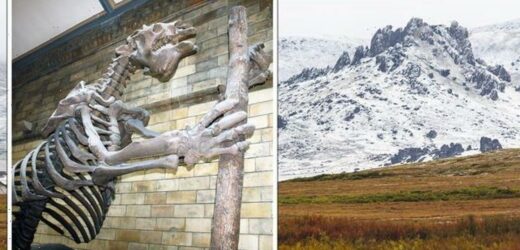US: Expert on early encounters with 'prehistoric mammals'
We use your sign-up to provide content in ways you’ve consented to and to improve our understanding of you. This may include adverts from us and 3rd parties based on our understanding. You can unsubscribe at any time. More info
The “Solutrean hypothesis” is a theory that claims the first people to arrive in the New World — the Americas — were from prehistoric Spain. It says they brought with them a distinctive way of making stone tools, which provided the basis for later Clovis technology that spread throughout North America. The biggest proponents of the theory today are Dennis Stanford, an archaeologist of the Smithsonian Institution, and Brace Bradley, his colleague.
They say that the people of the Solutrean culture some 21,000 to 17,000 years ago migrated to North America by boat along the pack ice of the North Atlantic Ocean.
Those who support it point to recent archaeological finds at Cactus Hill in Virginia, Meadowcroft Rockshelter in Pennsylvania, and Miles Point in Maryland as evidence of a transitional phase between Solutrean lithic and Clovis technology.
Shrouded in controversy and dismissed by many, their research was put into practice during the Smithsonian Channel’s documentary, ‘Ice Bridge: The Impossible Journey’.
Here, the early humans’ first encounters with animals in North America was explored, the “terrifying” extent to which the animals would have towered over the Solutreans laid bare.


According to the theory, they landed at Chesapeake Bay, the stretch of watershed that runs around 524 miles from Cooperstown, New York, to Norfolk, Virginia.
The documentary’s narrator noted: “Their first task is to find stones to make the tools and weapons on which their survival depends.”
The great canopy of icy wilderness would have contained flora and fauna never before encountered by the Solutreans.
North America at the time would have been home to “massive prehistoric mammals unlike any in Ice Age Europe”.
JUST IN: Rishi Sunak warned incomes hit by £1,000 cut – that’s BEFORE new taxes

The narrator continued: “Among them, one of the most terrifying predators of all time, the short-faced bear.
“Capable of chasing its prey at 25mph and reaching up to heights of 13 feet.”
The short-faced bear is thought to have become widespread around 800,000 years ago, eventually becoming extinct some 11,000 years ago.
There are two recognised species: the lesser short-faced bear (Arctodus pristinus) and the giant short-faced bear (Arctodus simus).
The latter is considered to be one of the largest known terrestrial mammalian carnivores that has ever existed.
The Solutreans would also have faced-down the numerous giant ground sloths that once roamed the Americas.
DON’T MISS
Russia sends terrifying threat as millions of Britons face winter cris [REPORT]
Bill Gates backs Brexit Britain as £10bn in investments secured by PM [INSIGHT]
Sky Glass review: First impressions of ambitious new streaming 4K TV [ANALYSIS]


Megalonyx jeffersonii was the largest of the ground sloths in the family Megalonychidae, reaching the size of an ox when fully grown.
It grew to around 3 metres in length, and could weigh up to 1,000kg.
Evolving in South America around 35 million years ago, the giant ground sloth eventually migrated to North America eight million years ago, preferring to dwell around rivers and lakes.
During the Pleistocene period, which both the short-faced bear and giant ground sloth lived through, the world experienced what is known as the Great Ice Age.
At this time, during its peak, as much as 30 percent of the Earth’s surface was covered by glaciers, with parts of the northern oceans frozen, leaving an environment in which only the hardiest of animals could survive.

In 2018, archaeologists discovered the fossilised footprints of ancient humans at White Sands National Monument in New Mexico.
At the same site, the researchers also found human footprints inside the footprints of giant ground sloths — leading scientists to believe that ancient humans once stalked and hunted the animal.
While the Solutrean hypothesis has been welcomed by some, others claim it is “scientifically implausible”.
Jennifer Raff, a geneticist, writing for The Guardian in 2018, said the theory “suggests a European origin for the peoples who made the Clovis tools, the first recognised stone tool tradition in the Americas”.

Having appeared in the documentary, Ms Raff wrote: “In addition to the scientific problems with the Solutrean hypothesis which I’ll discuss shortly, it’s important to note that it has overt political and cultural implications in denying that Native Americans are the only indigenous peoples of the continents.”
In the wake of the hypothesis, reports suggested it had been adopted by white supremacist groups, who interpreted the them to say that the “original inhabitants of the Americas” were “white Europeans”, and the present-day Native Americans are the descendants of “later immigrants” from Asia.
Ms Raff claimed: “Indeed, although this particular iteration is new, the idea behind the Solutrean hypothesis is part of a long tradition of Europeans trying to insert themselves into American prehistory; justifying colonialism by claiming that Native Americans were not capable of creating the diverse and sophisticated material culture of the Americas.”
She said the scientific evidence also raised eyebrows: “There’s a serious time gap between when the Solutreans could have crossed the Atlantic via the ice bridge (~20,000 years before present (YBP)) and when Clovis tools begin to show up in the archaeological record (~13,000 YBP),” and that, “there is no evidence of boat use, or tools used for making boats at Solutrean sites”, among other things.
Source: Read Full Article


